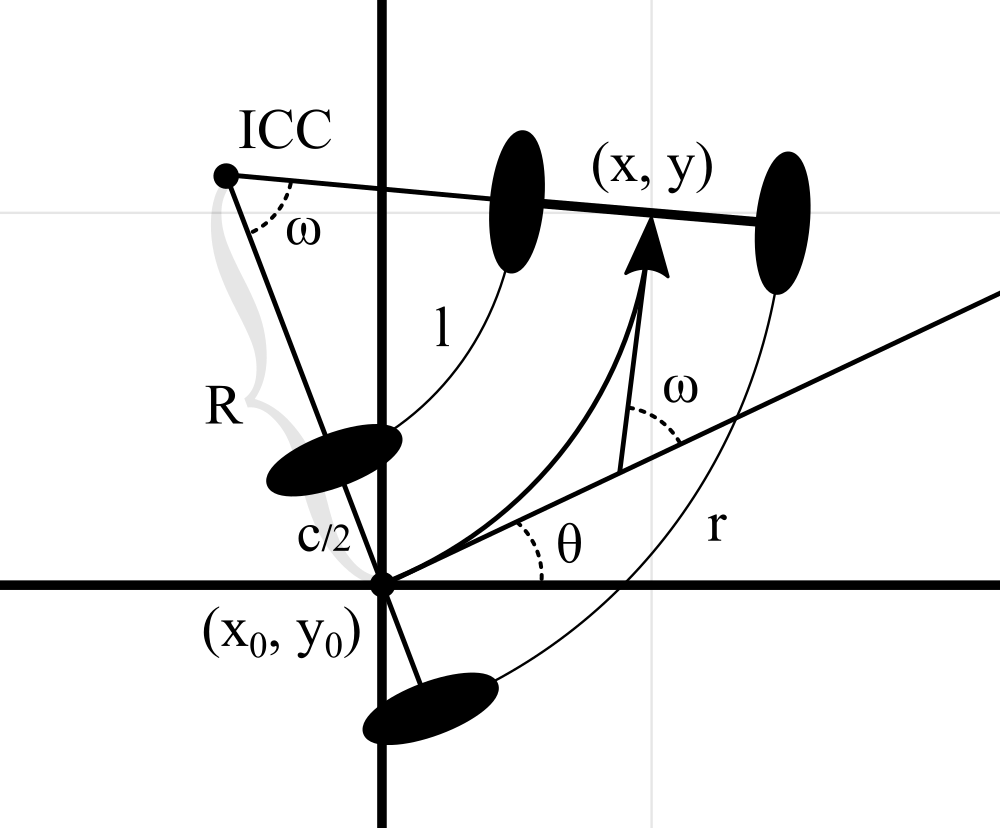Circle Approximation
Although the line approximation is relatively accurate, we can make it more precise by assuming that the robot drives in an arc, which, in reality, is closer to what the robot is really doing.

Deriving the equations
The robot moved in an arch, the left encoder measured a distance \(l\) and the right wheel a distance \(r\). It was previously at an angle \(\theta\) and is now at an angle \(\theta + \omega\). We want to calculate, what the new position of the robot is after this move.
The way to calculate the new coordinates is to find the radius \(R\) of ICC (Instantaneous Center of Curvature – the point around which the robot is turning) and then rotate \(x_0\) and \(y_0\) around it.
Calculating R
Let’s start by finding the formula for calculating \(R\). We will derive it from the formulas for calculating \(l\) and \(r\):
\[l = \omega \cdot \left(R - \frac{c}{2}\right) \qquad r = \omega \cdot \left(R + \frac{c}{2}\right)\]Combining the equations and solving for R gives us:
\[R = \left(\frac{r+l}{\omega \cdot 2} \right)\]From our previous article about Heading from Encoders, we know that \(\omega = \frac{r - l}{c}\). If we don’t have a gyro, we can just plug that into our newly derived formula and get:
\[R = \frac{r+l}{\frac{r - l}{c} \cdot 2} = \frac{r+l}{r - l} \cdot \frac{c}{2}\]Rotating \((x_0, y_0)\) around ICC
For this section, we will assume that you know how to rotate a point around the origin by a certain angle. If not, here is a video from Khan Academy deriving the equations.
First of, we will need the coordinates of the \(ICC\). Since it’s perpendicular to the left of the robot, we can calculate it by first calculating a point that is distance \(R\) in front of the robot:
\[ICC_x=x_0+R \; cos(\theta) \qquad ICC_y=y_0+R \cdot sin(\theta)\]We will then turn the point 90 degrees to place it at distance \(R\) perpendicular to the robot by switching \(x_0\) and \(y_0\) and negating the first coordinate (using simple vector algebra):
\[ICC_x=x_0-R \; sin(\theta) \qquad ICC_y=y_0+R \cdot cos(\theta)\]To rotate \((x_0, y_0)\) around ICC (and therefore find \((x, y)\)), we will first translate ICC to the origin, then rotate, and then translate back:
\[x = (x_0 - ICC_x) \cdot cos(\omega) - (y_0 - ICC_y) \cdot sin(\omega) + ICC_x\] \[y = (x_0 - ICC_x) \cdot sin(\omega) + (y_0 - ICC_y) \cdot cos(\omega) + ICC_y\]Plugging in the values for \(ICC_x\), \(ICC_y\) and simplifying:
\[x = R \; sin(\theta) \cdot cos(\omega) + R \cdot cos(\theta) \cdot sin(\omega) + x_0 - R \; sin(\theta)\] \[y = R \; sin(\theta) \cdot sin(\omega) - R \cdot cos(\theta) \cdot cos(\omega) + y_0 + R \; cos(\theta)\]Using trigonometric rules, the equations can be further simplified to:
\[x = x_0 + R \; sin(\theta + \omega) - R \; sin(\theta)\] \[y = y_0 - R \; cos(\theta + \omega) + R \; cos(\theta)\]Edge cases
There is one noteworthy case of values \(l\) and \(r\) where our circle approximation method won’t work.
If \(r=l\) (if we are driving straight), then the radius cannot be calculated, because it would be “infinite”. For this reason, our method can’t be used on its own, because if the robot drove in a straight line, the code would crash.
We can, however, still employ or line approximation method, since in this case, it really is driving in a straight line! It is also a good idea to apply the line approximation method for very small angles, since it’s almost like driving straight, and it’s less computationally intensive to the circle approximation method.
Implementation
Here is the implementation, combining both of the approximation methods:
from math import cos, sin
class CircleApproximation:
"""A class to track the position of the robot in a system of coordinates
using only encoders as feedback, using a combination of line and circle
approximation methods."""
def __init__(self, axis_width, l_encoder, r_encoder):
"""Saves input values, initializes class variables."""
self.axis_width = axis_width
self.l_encoder, self.r_encoder = l_encoder, r_encoder
# previous values for the encoder position and heading
self.prev_l, self.prev_r, self.prev_heading = 0, 0, 0
# starting position of the robot
self.x, self.y = 0, 0
def update(self):
"""Update the position of the robot."""
# get sensor values and the previous heading
l, r, heading = self.l_encoder(), self.r_encoder(), self.prev_heading
# calculate encoder deltas (differences from this and previous readings)
l_delta, r_delta = l - self.prev_l, r - self.prev_r
# calculate omega
h_delta = (r_delta - l_delta) / self.axis_width
# either approximate if we're going (almost) straight or calculate arc
if abs(l_delta - r_delta) < 1e-5:
self.x += l_delta * cos(heading)
self.y += r_delta * sin(heading)
else:
# calculate the radius of ICC
R = (self.axis_width / 2) * (r_delta + l_delta) / (r_delta - l_delta)
# calculate the robot position by finding a point that is rotated
# around ICC by heading delta
self.x += R * sin(h_delta + heading) - R * sin(heading)
self.y += - R * cos(h_delta + heading) + R * cos(heading)
# set previous values to current values
self.prev_l, self.prev_r, self.prev_heading = l, r, heading + h_delta
def get_position(self):
"""Return the position of the robot."""
return (self.x, self.y)